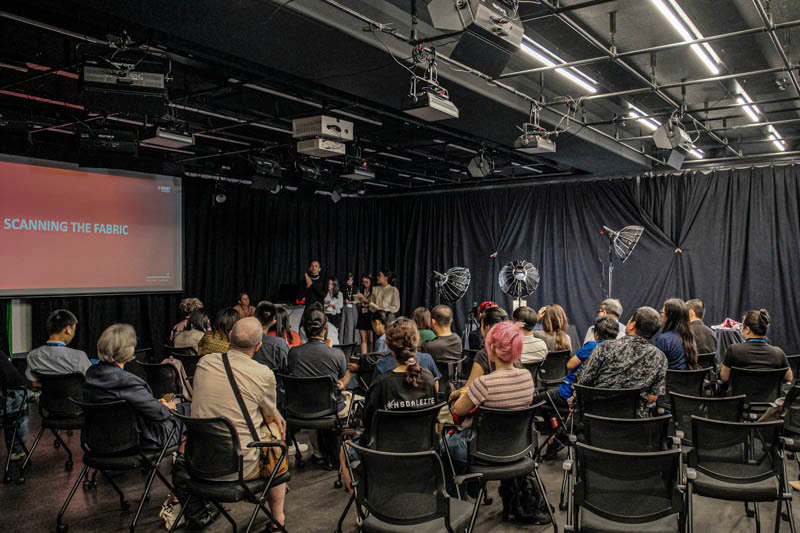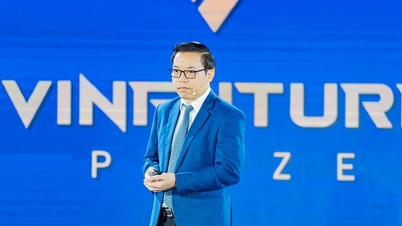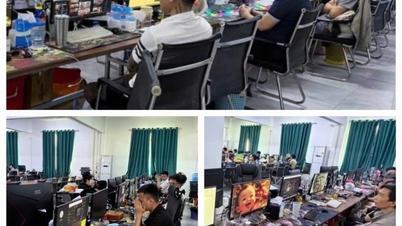Nowadays, artificial intelligence (AI) is having an increasingly profound impact on many aspects of life. The field of education and training is no exception. There are many questions surrounding the issue of whether AI can replace lecturers in the future or not?

Representatives from local museums and archives as well as RMIT Vietnam staff experienced the use of advanced 3D technology to preserve cultural heritage. Photo: RMIT
Is the role of the lecturer affected by AI?
According to research by Dr. Nguyen Van Dong (Saigon University), innovation in higher education is essential to link teaching with the development of technology. The use of artificial intelligence (AI) offers great potential to improve educational management in higher education through optimizing the teaching and learning process.
Research shows that AI has great potential to change the landscape of higher education in the direction of integration and development.
First, AI enables learning methods that are tailored to individual needs. With in-depth data analysis of student learning styles and progress, adaptive learning systems are structured to deliver more effective and efficient learning experiences.
Second, AI can analyze historical data to predict student behavior, such as academic performance, attendance, or even potential learning difficulties. This allows institutions to take preventative measures or intervene early to help students in need.
These benefits all show that AI is a tool used to support lecturers in teaching effectively.
On the same issue, Dr. Nguyen Minh Huyen Trang - Deputy Head of Student Affairs Department, Ho Chi Minh City National University affirmed: "Certainly AI cannot replace lecturers. Because students cannot effectively exploit this technology without being provided with background knowledge by lecturers."
Ms. Trang explained that if students are not provided with background knowledge, they will not be able to verify whether the drafts and content provided by AI are reasonable and accurate. According to her, the impacts of AI should be viewed positively. Because AI is a tool to help improve the quality of higher education.
The problem is that in order to provide knowledge to students, lecturers themselves need to update their knowledge. She believes that higher education institutions should invest in infrastructure, along with training lecturers to have the capacity to use, apply and exploit AI technology.
Another study by two authors Wahyudi & Sunarsi, (2021), with the research topic "Benefits of implementing knowledge management on lecturer performance during the Covid-19 pandemic" showed that AI helps maintain the effectiveness of lecturers' educational activities. According to the study, knowledge management encourages the emergence of a technology-based online education delivery system so that the performance of lecturers in the education sector is not reduced.
Challenges to Using AI Effectively in Teaching

As advanced AI systems become increasingly ubiquitous, students will need to learn how to use AI critically, ethically and in a way that is fit for purpose and context. Photo: RMIT
Although it offers great potential for educational development, there are still challenges in using AI effectively.
The study "Application of artificial intelligence in university management: Potential and challenges" by two authors Pham Thi Phuong Dung and Ho Xuan Vinh (Hung Vuong University, Ho Chi Minh City) has pointed out notable challenges for lecturers in particular and higher education institutions in general.
First, for security and privacy. The use of AI in education management requires access to large amounts of data, including personal information about students, lecturers and staff. If sensitive information is leaked or misused, it will not only affect the reputation of the educational institution but also cause harm to students.
Second is the lack of skilled human resources. Many lecturers and staff in education are not trained in AI and data analytics. This lack of skills can lead to ineffective technology implementation, wasting resources. Finding and recruiting highly qualified personnel in this field is also difficult, especially in the context of fierce competition between different educational institutions.
Third is the difficulty in integrating technology. Many current education management systems are not designed to integrate with AI and Big Data, leading to difficulties in synchronizing data and workflows. The lack of compatibility can slow down the transformation process and force schools to invest more in upgrading the system.
Fourth, high investment costs. Implementing AI and big data requires large initial investments in software, hardware, and human resource training. This can become a financial burden, especially for educational institutions with limited budgets. In addition, the cost of maintaining and updating technology can also be a significant factor, increasing the financial pressure on educational institutions.
Finally, there is the difficulty in analysis and decision making. Incomplete, inaccurate or outdated data can lead to poor decisions and negatively impact learning and management performance. Data analysis requires highly specialized skills, and many employees may find it difficult to access complex analysis tools.
What to do to use AI effectively in the teaching process
To use AI effectively, research by MSc. Pham Thi Phuong Dung and MSc. Ho Xuan Vinh (Hung Vuong University, Ho Chi Minh City) suggests five measures.
First, implement strong security measures, using encryption technology to protect data during storage and transmission. This ensures that even if data is compromised, the information remains secure. Apply multiple layers of authentication to prevent unauthorized access, in addition to password login, requiring users to authenticate via phone or email.
Second, training and skill development, providing courses on AI, data analytics and information technology for faculty and staff. Courses can be designed from basic to advanced. Along with that, organizing events to share knowledge and experience among industry experts as well as cooperating with technology companies to organize training programs and share resources.
Third, before implementation, it is necessary to research and select technology solutions that can integrate well with the current system. Conduct pilot projects to evaluate the feasibility of the technology before full implementation. Design a unified data system so that all data sources can be connected and used effectively.
Fourth, instead of investing heavily at the beginning, schools can start with small projects and gradually expand based on the results achieved. Conduct periodic reviews to adjust strategies and optimize costs.
Fifth, establish clear data collection, storage and processing procedures to ensure accuracy and completeness. Conduct regular audits to detect and correct inaccurate data. Organize knowledge sharing sessions from experts to improve common understanding of data analysis to support data management staff in detecting and handling data quality issues.
Source: https://danviet.vn/tri-tue-nhan-tao-ai-nguoi-ban-tot-hay-ke-co-the-thay-the-giang-vien-trong-tuong-lai-20241219114343297.htm


![[Photo] National Assembly Chairman Tran Thanh Man attends the VinFuture 2025 Award Ceremony](/_next/image?url=https%3A%2F%2Fvphoto.vietnam.vn%2Fthumb%2F1200x675%2Fvietnam%2Fresource%2FIMAGE%2F2025%2F12%2F05%2F1764951162416_2628509768338816493-6995-jpg.webp&w=3840&q=75)



![[Photo] 60th Anniversary of the Founding of the Vietnam Association of Photographic Artists](/_next/image?url=https%3A%2F%2Fvphoto.vietnam.vn%2Fthumb%2F1200x675%2Fvietnam%2Fresource%2FIMAGE%2F2025%2F12%2F05%2F1764935864512_a1-bnd-0841-9740-jpg.webp&w=3840&q=75)
































































































Comment (0)